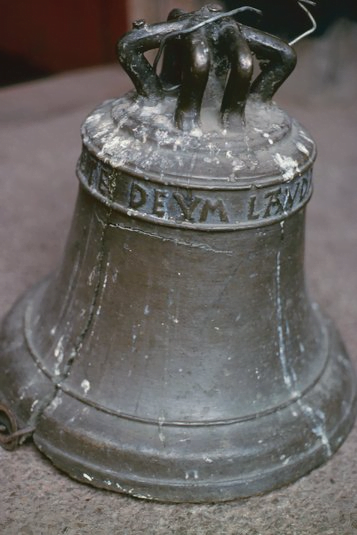Catholic Missionaries in Tibet: A Legacy of Efforts
Since the 17th century, Catholic missionaries have embarked on multiple missions to Tibet, albeit with outcomes characterized by failure. While in Tibet, the Catholic Church engaged in brief church construction and medical missionary work in Lhasa. Among the historical records kept in Rome, a bell, now housed in the Jokhang Temple in Lhasa, stands as a testament to their activities during that era.

The Jokhang Temple Bell
This cast iron bell bears a Latin inscription, “Song of Praise,” and measures 43.3 cm in height and 43.5 cm in width. Despite displaying cracks and damaged buttons, the bell has been preserved as an important relic. In the late 1990s, it was relocated from the roof of the Jokhang Temple’s corridor to the temple’s warehouse. Today, it draws Western tourists curious about its unique history. While the bell’s origin remains a subject of debate among scholars, some suggest it may have been crafted by a local artisan in Lhasa.
Discover the enduring legacy of Catholic missionary efforts in Tibet through artefacts like the Jokhang Temple bell, bearing witness to a chapter of history marked by determination and cultural exchange.
In March 1624 AD, a significant event unfolded as Catholic missionaries Antonio de Andrade and Manoel Manuel Marques embarked on a daring journey to Tibet. To seek out “wandering believers” in the mystical land of Tibet.
A Perilous Journey
Their expedition was far from ordinary. It involved numerous disguises, encounters with unforeseen obstacles, and countless twists and turns. However, in August of the same year, their perseverance led them to their destination – Zhaburang, in the region of Guge, which is present-day Zanda County, Ngari Prefecture, Tibet.
Pioneering Catholicism in Tibet (August 1626 AD)
The year 1626 AD marked a historic moment in Tibetan history. Western missionaries achieved a significant milestone by completing the first Catholic church in Tibet, located in Zaburang. This church served as their headquarters for conducting missionary activities among the Tibetan people.
Facing Opposition (1630 AD)
Despite their ambitious efforts, the Western missionaries faced strong opposition from the Guge regime and encountered resistance from Buddhist forces in 1630 AD. Their actions were perceived as a threat to the interests of Buddhist believers and drew significant backlash from Guge monks and the general public.
Shigatse Missionary Activities (1628-1632 AD)
In 1628 AD, responding to Antonio de Andrade’s suggestion, the Catholic Bishop of Goa dispatched missionaries Cacella and Cabral to Bhutan and eventually Shigatse. Although they were allowed to conduct missionary activities by Zangba Khan, they faced staunch opposition from Buddhist believers and the local population.
The End of Catholic Missionary Activities (1632 AD)
Regrettably, the Catholic missionary activities in Shigatse concluded in 1632 AD, marked by the closure of the missionary society. However, the spirit of perseverance and determination remained undeterred. Explore the captivating journey of Western missionaries in Tibet during the early 17th century.
Missionary Ventures in Tibet (1661-1846 AD)
A Challenging Start (1661 AD)
In 1661 AD, missionaries Bai Naixin and Wu Erduo embarked on an arduous journey from Beijing. Their route took them through Xi’an, Xining, and finally to Lhasa in October of the same year. However, due to financial constraints, their mission to preach in Lhasa was cut short. They journeyed from Nepal to India and eventually returned to Rome in February 1664.
Persistent Missionary Efforts (1704-1745 AD)
Starting in 1704 AD and spanning over 41 years, the Catholic Order of Kapu’s headquarters sent more than 40 missionaries on multiple occasions to Lhasa. These dedicated individuals arrived in Lhasa and engaged in missionary activities, demonstrating unwavering commitment.
Opposition and Ban (1745 AD)
In 1745 AD, the strong rejection and opposition from Lhasa’s monks and laypeople compelled Chief Kalon Phola Nai to take a decisive step. He banned the Catholic Church’s missionary activities in Lhasa, thereby bringing an end to the efforts of the Kapuqing Tibetan Missionary Society.
French Missionaries Face Deportation (1846 AD)
Fast forward to 1846 AD, French missionaries Gubocha and Gabi ventured into Tibet from Mongolia via Qinghai. Their mission led to the establishment of a small church in Lhasa for preaching. However, their presence drew the attention of Qishan, the Tibetan minister in charge, who ordered their deportation and escorted them out of Tibet.
Explore the challenging and resilient history of missionary ventures in Tibet, marked by determination, opposition, and perseverance.
The Catholic Missionary Journey (1855-19th Century)
A Missionary Station in Eastern Tibet (1855 AD)
In 1855 AD, French Catholic missionaries embarked on a journey to Bomuga in eastern Tibet, travelling via Deqin County in Yunnan Province. They established a missionary station in this remote region. However, their mission faced a turning point in 1865 when an anti-Catholic movement erupted, compelling the missionaries to leave Bomuga for Yaljing in Tibet.
270 Years of Tenacity (17th-19th Century)
From the early 17th century to the late 19th century, the Catholic Church displayed unwavering dedication to its missionary activities in Tibet, spanning over 270 years. Despite their determination, these missionaries encountered significant challenges and experienced heartbreaking setbacks.
The Last Catholic Church in Tibet (Present Day)
Today, only one Catholic church remains in Tibet, located in Yanjing, Mangkang County, Qamdo City. This church holds a translated Tibetan version of the Bible, and its believers receive names from priests, often with a European influence. Even funerals follow Catholic rituals. This solitary church serves as a beacon of faith in Tibet, a testament to the enduring spirit of the Catholic mission.
Explore the remarkable and enduring legacy of Catholic missionary efforts in Tibet, marked by challenges, perseverance, and the preservation of faith.





